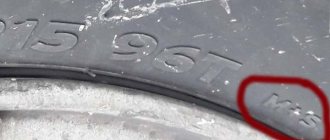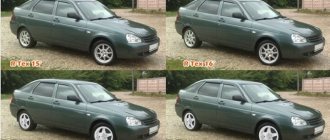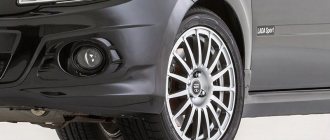Why check tire pressure?
The catalyst for many accidents is worn-out car tires, and the most serious tread damage occurs on overinflated or low tires.
In the first case, the center of the treadmill burns out - because of this defect, the braking distance increases and the number of accidents during emergency braking increases. In the second case, the edge of the tread wears off - this defect leads to loss of traction when maneuvering. However, incorrect tire pressure can lead to unpleasant consequences not only in the long term. A car driver who ignores the wheel control system signals faces the following problems:
- loss of dynamics - accelerating to 100 km/h in 7-10 seconds will no longer be possible;
- decreased controllability - the car skids when turning even on a dry road;
- increased fuel consumption - instead of the expected 4.6-9.8 per 100 km, the Mazda CX5 will “eat” up to 8-12 liters.
If the tire pressure monitoring sensor is on on the dashboard, do not ignore it, but try to deal with the problem that has arisen.
Why You May Need to Disable TPMS
This electronic system indirectly measures the pressure in the vehicle's tires, as well as the temperature. Typically it is software built into the ABS control unit and wheel speed sensors.
The control unit receives a wireless signal from 4 sensors about the angular speed of the wheels. If the tire pressure drops, its radius decreases slightly, and so does the angular speed of rotation.
- Temperature also affects the amount of pressure, which decreases when the gas (nitrogen or air) in the wheel cools.
- The control unit monitors the readings of the sensors on all wheels and, if there are discrepancies, sends a signal to the dashboard.
- Pressure monitoring using TPMS has some disadvantages:
- A long turn at low speed can trigger a malfunction signal in the system, since the angular speeds of the wheels on different sides will differ.
- When replacing wheels along with rims, for example, for a winter version where tire pressure sensors are not installed, the TPMS will constantly generate an error and a yellow or red symbol will light up on the panel.
- When purchasing wheels with Run-Flat technology (which makes it possible to drive on a flat tire for some part of the road), the TPMS control system will not operate due to the preservation of the diameter, and therefore the angular speed of the wheel during a puncture.
After a symbol indicating an error in the pressure control system is displayed, or a constant alarm indicating low pressure in one of the wheels, many drivers prefer to remove the malfunction notification from the dashboard. Periodic (continuous) display of the symbol distracts attention from the instrument readings.
Troubleshooting options
Alternatively, the car owner can purchase new sensors for winter tires, which cost 3,000–4,000 rubles. per piece or replace the “original” ones with new wheels. You will need to go to a service station and remove the tires to get to the sensors. All this is troublesome and expensive.
Different brands of cars come with different software, so your shutdown options may vary. Let's look at how to disable tire pressure sensors in accessible ways:
- For example, for the BMW Series 3, you can use the JB4 chip - a chip tuning used to correct some errors in the programs of the electronic control unit, as well as to optimize fuel consumption. You need to enter the settings by simultaneously pressing the “channel” and “volume” keys. By pressing “volume”, menu 4, option 6 is selected. Next, by clicking on the same button, we turn off the command mode. The TPMS system should turn off. Other car brands use their own chips.
- An attempt was made to clear an error using the TPMS reset command. In any car model where this system exists, you can reset it. The location of the button (set, reset, etc.) can be found in the vehicle’s technical manual. Before resetting the control system, you must turn the ignition key to the “on” position. Next, press the reset button for a few seconds until the yellow symbol on the panel flashes three times. Start the car for 10–15 minutes. for new sensor calibration.
- Another option is to try deflating and re-inflating the tires to the manufacturer's recommended pressure and use a hand-held pressure gauge to check.
- Reboot using the battery. In this case, all electronics will reboot. Disconnect the negative terminal of the battery for a while.
- Find the fuse box, sometimes it is located on the driver's side door. Usually there are names on the inside of the cover, you need to select “TPMS”. Pull out the fuse.
Tip: It is better to leave the pressure monitoring system in working order, as it can prevent an accident on the road if the tire is quickly punctured while the car is moving at high speed.
Video on the topic
How to disable sensors that measure tire pressure Link to main publication
Tire pressure sensor Mazda CX 5: characteristics and code
Tire pressure sensor
Statistics of accidents on the road eloquently show: one of the most common causes of danger on the road is tires. In winter, this may be due to lost studs or worn out tread pattern. Traditionally, less attention is paid to summer tires, but this is also an important safety parameter.
However, pressure plays an equally important role in ensuring peace of mind on the road. It is not by chance that the manufacturer puts the recommended indicators in the instruction manual. It varies depending on the type of body, the weight of the car, its speed characteristics and, finally, the size of the wheels.
Modern, innovatively equipped cars are equipped with intelligent systems that specialize in monitoring pressure indicators. They are necessary to ensure rapid response to important changes in tires.
- Red car Mazda CX-5 a
- The system will not work correctly if the wheel size does not correspond to the regulated size.
- For the Mazda CX-5, the following dimensional differentiation is relevant:
- R17 – suitable for all generations,
- R18 – only for cars produced in 2014,
- R19 – for all generations.
Summer tires for Mazda CX 5
In this case, the pressure value depends on this indicator.
2.3 bar is recommended for 17th and 18th wheels. R19 – 2.5 bar.
The pressure sensor (TPMS) is activated when the engine starts. It lights up when ignited and goes out if everything is in order. If the pressure in any wheel does not correspond to the regulated pressure, the on-board computer highlights it in red.
In the catalog list, this spare part has article number BHB6-37-140. The quality of the product is guaranteed by Siemens (VDO) France.
According to forums and reviews from car enthusiasts, with correct installation and strict adherence to operational nuances, the uninterrupted service life of the sensor is from 8 years.
Pressure meter
However, there is no specific control system option for the CX-5. The concern distributes one type of sensor to almost the entire model range.
When purchasing a part, a nipple is included in the kit. Installation of the sensor is accompanied by mandatory binding and activation.
Mazda has an automatic binding type. This happens during a test drive.
Entering the device binding mode occurs by resetting the previous settings via the on-board computer. On new versions of cars, the sensor is built in without the need for this procedure.
- Binding algorithm:
- Mazda CX-5 interior
- Installation of the device on a car,
- Inflating tires to the required level,
- In the on-board computer, select “system reset”, or on the dashboard, deactivate the pressure monitoring system (if the required key is present on the dashboard).
- To set up the correct operation of the sensor, it is recommended to operate the car for half an hour at a speed of 50 km/h.
In the case when the sensor is changed in the spare wheel, it is linked using the diagnostic console. The identifier of a specific device is entered into the car’s intelligent system.
How does the Mazda CX5 tire pressure monitoring system work?
The wheel control system can be direct or indirect. The first technology relies on controllers built into the tire. The second system operates with data on the size of the wheel and the associated angular velocity. Mazda's designers opted for an indirect TPMS system.
The main components of the TPMS system are software and four sensors that monitor the angular speed of the wheel. A flat or overinflated tire changes its outer diameter, causing the angular speed to decrease or increase. The control sensor checks this indicator while driving, and the software compares the received data with the basic values. If the basic values deviate, the “Tire pressure error” signal lights up on the dashboard.
For the TPMS system to work, you need to initialize the software and sensors. Without prior activation and calibration, the number of false alarms increases (the signal will remain on even if the tire is correctly inflated).
How do sensors work in a Mazda CX-5?
In the Mazda CX-5, tire pressure monitoring (TPMS) is carried out simultaneously on all sides when the engine is started. The sensor lights up after the engine starts, going out after a few seconds. During this time, real indicators are checked and compared with the regulated ones. If there are no deviations, the system switches to passive tracking mode. There is no control during parking. Activation of the sensor while driving signals the need for immediate adjustment. After adjusting the indicator to the standard value, the signal light goes out.
Read also: Mazda CX 5 2021 new video
The system may fail or hide the problem when:
1) simultaneous use of different types of tires or unsuitable wheel sizes for Mazda CX-5.
2) Tire puncture.
3) Driving on bumpy or icy roads.
4) Driving at low speeds.
5) Traveling short distances.
According to the diameter of the tires, the pressure in the Mazda CX-5 r17 tires should be 2.3 atmospheres; for the R19, 2.5 atmospheres is considered the norm. The indicator is identical for the front and rear axles of the car. These values are regulated by the manufacturer and specified in the technical documentation.
Tires can deflate over time by exchanging air with the environment through the pores of the rubber. In summer tires for the Mazda CX-5, the pressure increases with increasing temperature, but in winter this figure drops by an average of 0.2-0.4 atmospheres per month.
The operation of the sensors is not affected by which tires are installed on the Mazda CX-5 (R17 or R19). Even when replacing tires or wheels, the system automatically changes settings and calibrates data for new operating conditions.
Regular tire pressure is the key to safety on the road and extends the life of the rubber. The electronic TPMS system in the Mazda CX-5 promptly informs the driver of deviations from regulated standards.
Insufficient or too high tire pressure leads to reduced vehicle safety, deterioration of dynamic characteristics and causes increased fuel consumption. Therefore, the Mazda CX 5 uses special sensors.
They promptly detect and inform the driver about deviations in tire pressure from the norm.
Popular tire models
- Yandex.Market rating: Yandex.Market: 4.5
Goodyear Eagle Sport TiresSeasonality: summer Spikes: no Diameter: 14 / 15 / 16
- Yandex.Market rating: Yandex.Market: 4.5
Goodyear UltraGrip Ice+ tires
Seasonality: winter Spikes: no Diameter: 14 / 15 / 16 / 17
- Yandex.Market rating: Yandex.Market: 4.5
Goodyear EfficientGrip Performance Tires
Seasonality: summer Spikes: no Diameter: 15 / 16 / 17 / 18 / 19 / 20
- Yandex.Market rating: Yandex.Market: 4.5
Goodyear UltraGrip Ice 2 tires
Seasonality: winter Spikes: no Diameter: 14 / 15 / 16 / 17 / 18 / 19
- Yandex.Market rating: Yandex.Market: 4.5
Goodyear Vector 4Seasons tires
Seasonality: all-season Spikes: no Diameter: 14 / 15 / 16 / 17 / 18
- Yandex.Market rating: Yandex.Market: 4.5
Goodyear Eagle Sport TZ tires
Seasonality: summer Spikes: no Diameter: 16 / 17 / 18
- Goodyear UltraGrip Arctic 2 tires
Seasonality: winter Spikes: yes Diameter: 16 / 17 / 18 / 19
- Yandex.Market rating: Yandex.Market: 4.5
Goodyear UltraGrip Ice SUV Tires
Seasonality: winter Spikes: no Diameter: 16 / 17 / 18 / 19 / 20
- Goodyear UltraGrip Arctic 2 SUV Tires
Seasonality: winter Spikes: yes Diameter: 17 / 18 / 19 / 20 / 21
- Yandex.Market rating: Yandex.Market: 4.5
Goodyear Wrangler All-Terrain Adventure tires with Kevlar
Seasonality: summer Spikes: no Diameter: 15 / 16 / 17 / 18 / 19 / 20
- Yandex.Market rating: Yandex.Market: 5
Goodyear Eagle Sport SUV TZ tires
Seasonality: summer Spikes: no Diameter: 17 / 18
- Yandex.Market rating: Yandex.Market: 4
Goodyear Wrangler HP All Weather Tires
Seasonality: summer Spikes: no Diameter: 15 / 16 / 17 / 18 / 19
- Yandex.Market rating: Yandex.Market: 4.5
Goodyear EfficientGrip SUV Tires
Seasonality: summer Spikes: no Diameter: 16 / 17 / 18 / 19 / 20 / 21 / 22
- Yandex.Market rating: Yandex.Market: 4
Goodyear UltraGrip Performance 2 Tires
Seasonality: winter Spikes: no Diameter: 16 / 17 / 21
- Yandex.Market rating: Yandex.Market: 5
Goodyear Eagle F1 SuperSport Tires
Seasonality: summer Spikes: no Diameter: 18 / 19 / 20 / 21
- Yandex.Market rating: Yandex.Market: 4.5
Goodyear Eagle F1 Asymmetric 3 SUV tires
Seasonality: summer Spikes: no Diameter: 17 / 18 / 19 / 20 / 21 / 22
- Goodyear Eagle F1 SuperSport RS Tires
Seasonality: summer Spikes: no Diameter: 21
How to initialize a TPMS system - step-by-step guide
- Inflate all four tires of your Mazda CX5 to the recommended internal pressure. For R17 format tires the recommended value is 2.3 bar, for R19 - 2.5 bar.
- Insert the key into the ignition. Turn it to the ON position and return it to LOCK. This way you activate the on-board network to which the air control system is connected.
- Wait at least 15 minutes. During this time, the on-board computer will catch the sensor signal, read its ID and register the bus controller. If you want to play it safe, wait 20 minutes.
- Start the car, start driving and pick up speed up to 25 km/h. Maintain this speed for 10 minutes while driving on a level road.
- Check the TPMS system indicator - it should show the correct pressure. If an error signal is on on the panel, press the TPMS SET button, which will reset the controller binding. After the reset, repeat the binding according to the described scheme.
Cost and article number for sensors for Mazda CX 5
The original tire pressure sensor for the Mazda CX 5 has the article number BHB637140. Its price ranges from 2000 to 4000 rubles. Sensors from third party manufacturers are commercially available. The table below shows the best analogs that have proven themselves on the Mazda Cx 5.
Table - Tire pressure sensors Mazda CX 5
| Firm | Catalog number | Approximate cost, ruble |
| Jaguar | C2C41655 | 6000-9000 |
| Mobiletron | TXS034 | 1300-2800 |
| Volvo | 31341893 | 5000-7000 |
You can check the functionality of the sensor by forcibly releasing some of the air from the wheel. In this case, after a while a message indicating that the tire pressure is too low should appear. Checking the TPMS system is also possible by reading errors from the on-board computer.
When does the control system fail?
The indirect TPMS system is not a 100% reliable method of pressure control. It happens that it gives an error in which the signal is on, and the pressure in the wheel is normal. Most often, such a failure occurs when tires of different models are installed on car rims. Another reason may be driving on a bumpy road, during which the wheel dimensions change for natural reasons. The error can also be seen when taking a turn in a long arc.
The sensor does not operate at speeds below 25 km/h, or when tires with rigid sides (Run-Flat models) are installed on the vehicle. Another reason for the lack of a signal may be the replacement of the disk, during which they forgot to install the angular velocity controller.










